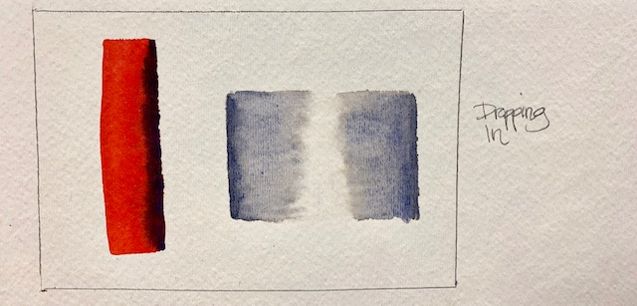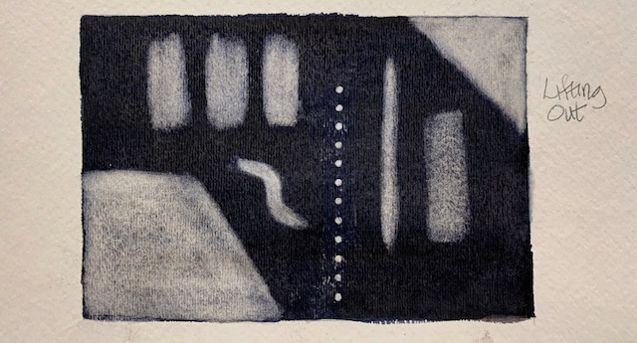I’ve got a newsletter now! Subscribe here. I’ll give a free copy of my blending tip pdf.
DROPPING IN paint is introducing another color to a still-wet wash. The second color will soften into the first color, subtly blending on its own. This painting technique can create the illusion of shape in a curved object (for example, a tree trunk, flagpole, fencepost, chair leg, or arm) and can also help suggest depth in a painting.
To drop in, put down some color on paper, not too wet. Then mix a second color, a little darker than the first. Drop the second color into the wet first wash along one side with a light touch. Put a little color in at first, adding more (while everything is still wet) only if necessary.

Many painters almost unconsciously LIFT OUT paint to adjust tones and colors while they are painting. You can deliberately draw out color from “too dark” areas, when the paint is still wet, by using a slightly damp brush (as you would a sponge) to lift off or soak up pigment.
Be careful, however, if you paint with a staining color, because lifting out paint will be much more difficult (if not impossible). If you want to lift out paint from a dark area, make sure you use non-staining colors. Try to lift out paint soon after the paint has dried, because then you won’t need to put in as much effort as you would when the paint has set and dried for several days.

If you want to lift color from a large area, wet the area, allow the water to settle in to the paper and moisten the pigment, then work the brush over it (tickle the area) to start moving the pigment. As the pigment softens and becomes moistened, lift out with a slightly damp (not dripping wet) brush. The brush needs to be drier than the paint, or it cannot absorb and lift out the wet pigment. If your brush becomes wet and full of paint while you are lifting, you will need to rinse and slightly dry the brush again (and perhaps repeat the process several times). Tissues and paper towels can also blot up unwanted color. Use a clean paper towel, for instance, and blot straight up; do not rub.
If you wish to lift paint from a smaller area, moisten just the area you want to lighten. Only moistened paint will lift. An erasing shield (or a piece of paper or cardboard or even #810 clear Scotch tape) and a small stiff brush will make it easier to lift along a straight, sharp line or small specific area.
All great info for trying to manipulate paint to the way you need it. Not so easy as we all quickly find out when painting wet in wet. Thanks! 🙂
LikeLike
Evaluating wetness – how wet your paint is, whether on the palette, on the paper, or on the brush – that is definitely one of the trickiest things about watercolor! What a challenge, a puzzle to be figured out.
Thanks for your comment!
LikeLike